Harriet Beecher Stowe had a profound effect on nineteenth-century culture and politics, not because her ideas were original, but because they were common. Somewhat paradoxically, she remains one of the most controversial writers America has produced. What makes Stowe so radical is that she insisted upon putting her ideas into action. As Jane Tompkins has written about Uncle Tom's Cabin, "Stowe's very conservatism — her reliance on established patterns of living and traditional beliefs — is precisely what gives her novels revolutionary potential."*
Harriet Beecher was born in Litchfield, Connecticut, in 1811, the sixth child of Lyman Beecher and Roxana Foote. Her father was the best known evangelical preacher of the antebellum era. Born in 1775, that revolutionary year, he was determined to have a powerful role in the shaping of the new republic. The first of his sermons to bring him national attention was an attack on what he considered the anti-democratic practice of dueling. Preaching at a time when religion and politics were closely allied, Lyman Beecher also condemned what he considered the "national sin" of intemperance and the horrors of slavery. Harriet's mother was as private and retiring as her father was public. Roxana Foote Beecher embodied what the nineteenth century termed "true womanhood," summarized by historian Barbara Welter in four cardinal virtues: piety, purity, domesticity, and submissiveness.* That was all a proper nineteenth century middle class woman was expected to be or do. Roxana died at the age of 41 of tuberculosis, worn out by frequent childbearing and the hard work of maintaining a family on a preacher's salary.
Harriet Beecher Stowe discovered a way to combine the strongly marked gender roles of her parents. Writing was an activity pursued in the parlor — in the private sphere where women were expected to be — yet when writings were published they reached an even broader audience than Lyman Beecher was able to fit in his church. In the days before commercial entertainments, families made their own amusements in the parlor; they played music, created amateur theatricals, or read aloud stories and poems written for the occasion. Far from being a departure from women's social role, writing was an integral part of it. Participating in literary games and writing letters to distant family members were simply extensions of women's role to maintain the bonds of family. The needle and the pen were not that far apart. Litchfield boasted a vibrant literary culture — it had a law school, a female academy, and some of the most cultivated minds of the age. Literary salons were a regular feature of Litchfield society, and the Beecher parsonage when it was not hosting these had as many as twenty-five people living under its roof who provided a ready audience for domestic literature. Harriet remarked that hardly anything happened in their household without her older sister Catherine picking up a pen and turning into a humorous composition. Harriet, who was the chief mourner at funerals for animals, remembered Catherine's epitaph for a dead cat:
Here died our kitIt's not great poetry, but it conveys the ordinariness of writing and the ease with which the everyday doings and sayings of the Beechers passed into literature. At this time there was no such thing as American literature — the periodicals were filled with material pirated from Britain. International copyright had not yet been established, and most editors thought it foolish to pay for what they could take for free, an attitude that slowed the development of our national literature. An exception was Sarah Josepha Hale, who paid authors fifteen dollars a page for stories published in her Godey's Ladies Book. As a consequence, Godey's sported not only the fashion plates for which it is most remembered, but stories by Stowe, Hawthorne and Poe. It was women who saw the potential for making literature a career, who wrote the first best sellers, and who laid the groundwork for the creation of American literature.
Who had a fit,
And acted queer.
Shot with a gun,
Her race is run,
And she lies here.
Harriet Beecher was well prepared for her literary career, not only by her informal education in the parlors of Litchfield, but also in Sarah Pierce's Litchfield Female Academy, which she entered at age eight. She soon became a regular writer, offering at age nine to write weekly compositions. When she graduated at age thirteen, her composition was read aloud at the school exhibition. It was entitled "Can the immortality of the Soul be proved by the light of nature?" She argued the negative. When he heard the essay, Lyman Beecher leaned over to the person next to him and asked who wrote it. When the answer came, "your daughter, sir," Harriet experienced the proudest moment of her life.
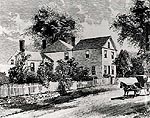
CLICK IMAGE TO ENLARGE
She continued her education at the Hartford Female Seminary, founded by her sister Catharine. Eleven years older than Harriet, Catharine acted as mother and mentor from the time of Roxana's death in 1816. Aware that whatever knowledge she possessed had "walked into her head," Catharine determined that Harriet's experience would be different. The first tasks she set her sister were in Latin and Greek, thought to be among the most difficult subjects in the male curriculum. Like the Litchfield Female Academy, Catharine's school offered far more than the "ornamental" education that had been the rule for women — a little music, painting on fans, the social graces that made women marriageable. The curriculum of both schools included rhetoric, geography, the natural sciences, history, mathematics, and moral philosophy — thought to be the most important subject in the male college curriculum and typically taught by the president of the college. Thus Harriet Beecher enjoyed an education equivalent to that of a man. At sixteen (the age that a woman's education was considered complete) she extended her education for five years by becoming a teacher of composition at her sister's Hartford Female Seminary.

CLICK IMAGE TO ENLARGE
In 1832 Lyman Beecher accepted the presidency of Lane Theological Seminary in Cincinnati and removed his large family from New England to Ohio. Schools and seminaries were part of his plan to "save the West" from the increasing numbers of Irish and German immigrants who were pouring into the Mississippi Valley. With their beer drinking and their Catholicism, they threatened Lyman Beecher's vision of a protestant evangelical republic. The twenty-one-year-old Harriet Beecher approached the West in a more open and tolerant spirit. She saw the vastness of the country and observed with pleasure the diversity of cultures and voices. A year later she published her first book, a Geography, where, with some local pride, she displayed a picture of the Cincinnati landing, where the confluence of the Mississippi and Ohio Rivers created a great center for trade in what was called "the London of the West." There one could see people from many different regions and parts of the world, speaking in many different languages and accents. These voices began making their way into Harriet's writing as she pioneered the use of dialect.
She was at this time a member of the Semi Colon Club, a literary salon which met on Monday evenings throughout the academic year. Members would gather to socialize, drink Madeira, flirt, discuss the latest topics of the day, and listen to the reading of stories and poems that had been written by its members. An appointed reader (apparently always male) would read the submissions anonymously. Then the group would engage in free discussion and criticism, made more frank by the practice of keeping the writer's name unknown. One can imagine how useful such an apprenticeship would be to an aspiring writer. Perhaps even more important to Harriet Beecher was the intimate nature of this gathering in the parlor. She could see the faces of her audience and observe what moved them, what made them laugh, what reminded them of the New England many of them had left behind. She developed what would become the hallmark of her prose, an intimate narrative voice. Her first published story was written for the Semi Colon Club. Entitled "Uncle Lot," it was based on stories she had heard over and over again in Litchfield about Lyman Beecher's uncle, Lot Benton. Refracting these childhood stories through the lens of her western experience, she could now see Uncle Lot as more than just an eccentric; he was a social type, the New England farmer. Uncle Lot was the first of the regional types with which she would people her fiction. If moving to Cincinnati provided Harriet Beecher with a national experience, it also allowed her to see more clearly where she had come from. When she came to Cincinnati, she was a New Englander; when she left eighteen years later, she was an American. The West was the cradle of her career.
In 1836 she married Calvin Stowe, a professor of the Bible at Lane Seminary. Valedictorian of his class at Bowdoin College and master of five biblical languages, he was a good intellectual match for the highly educated, literary Beecher whom her brothers and sisters called a blue stocking and feared would never marry. For his part, Calvin Stowe was smitten with the Beechers and their grand schemes to redeem the West and everything else in their path. He supported Harriet in her literary career, famously telling her when she was on the verge of publishing her first collection of stories, "My dear, you must be a literary woman." Harriet was at this point signing her name "Mrs. H. E. Beecher Stowe." Calvin advised her to drop the E out of her name: "write yourself only and always Harriet Beecher Stowe, which is a name euphonious and full of meaning."

DETAIL: CLICK
IMAGE TO ENLARGE
The year after she was married, an antislavery riot occurred in Cincinnati. A border city situated just across the river from the slave state of Kentucky, Cincinnati was in many ways a southern town. After James G. Birney set up his printing press and began publishing his antislavery paper, The Philanthropist, a mob broke into his office, seized his printing press and threw it into the river. The first antislavery battles were battles over free speech. Harriet, pregnant with twins, seized the opportunity to write an editorial for the Cincinnati Journal protesting mob rule and suppression of contrary views. Her brother Edward was present when Elijah Lovejoy was murdered in Alton, Illinois for attempting to publish his antislavery paper, and many of her siblings were taking public roles in the slavery controversy. Harriet, for the most part, was content to observe the increasingly fractious national debate from the sidelines, only occasionally stirring the pot in order to see the steam rise.
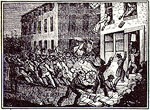
CLICK IMAGE TO ENLARGE
Her writing of Uncle Tom's Cabin was precipitated by two events, one in her personal life and one in the public arena. In 1849 her sixth child, Samuel Charles, died in a cholera epidemic in Cincinnati. Cholera was a relatively new disease in the Western hemisphere and inspired dread partly for that reason and partly because it was so deadly Three thousand people died in Cincinnati in the epidemic of 1849. We know today that cholera is spread by dirty water, but the germ theory of disease was not at that time understood. To people in the nineteenth century it was an act of God, a biblical plague. When Charley fell ill, Harriet wrote to Calvin that she had little hope of his recovery. There was no medical intervention available at the time, and all Harriet could do was watch helplessly while her eighteen-month-old child was wracked by convulsions and lost all the fluids in his body. She later wrote that there were circumstances of such bitterness in the manner of Charley's death that she didn't think she could ever be reconciled for it unless his death allowed her to do some great good to others. She also wrote that losing Charley made her understand what a slave woman felt when her child was taken away at the auction block.
The year following Charley's death Congress passed the Fugitive Slave Law. This law, like the Compromise of 1850 of which it was a part, was an attempt to hold the nation together around the contradiction of slavery in a democratic country. It required citizens to assist the sheriff in catching runaway slaves, stipulating fines and imprisonment for those who refused. No longer could the North pretend that "the peculiar institution" was just the South's problem. The Fugitive Slave Law brought slavery home to the doorsteps of northerners, who had to decide what they would do if a fugitive slave came knocking at their door for assistance. Stowe wrote Uncle Tom's Cabin to encourage citizens to disobey what she took to be an unchristian law and to engage white parents, many of whom, she knew, had lost a child, in the deep question of what a slave parent feels.
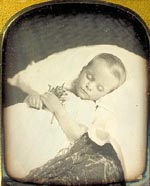
CLICK IMAGE TO ENLARGE
She wrote to Gamaliel Bailey, editor of the National Era, proposing what she thought at the time would be a series of three or four sketches. Her letter reveals the urgency with which the slavery question now occupied her:
Up to this year I have always felt that I had no particular call to meddle with this subject, and I dreaded to expose even my own mind to the full force of its exciting power. But I feel now that the time is come when even a woman or a child who can speak a word for freedom and humanity is bound to speak. The Carthagenian women in the last peril of their state cut off their hair for bow strings to give to the defenders of their country, and such peril and shame as now hangs over this country is worse than Roman slavery, and I hope every woman who can write will not be silent.
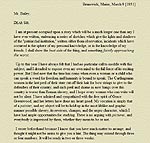
CLICK TO SEE LETTER
Her story began appearing in weekly installments, beginning with the June 5, 1851 issue of the National Era. and would run for nearly a year. In the first scene, a slave master in Kentucky, Mr. Shelby, is negotiating with a slave trader, Mr. Haley. Shelby is not an unkind master — he even lets his slaves read and practice religion — but Mr. Shelby is in debt and Haley holds the note he must make good. Shelby agrees to sell Tom, the slave who has raised him and who, because of his exceptional loyalty, trustworthiness, and Christian character, is very valuable. While Stowe engages in strategic satire of the scale of values being applied to Tom, Haley observes that he is not quite enough to cover the debt. At this point in the negotiation into the room comes Harry, the five-year-old child of slave woman Eliza. Taken with the boy and thinking to raise him for the "fancy trade," Haley agrees that if Shelby will include him, he will write off his note. Meanwhile, listening on the other side of the wall is Eliza, the child's mother, who understands that Mr. Shelby plans to sell her child. She resolves to steal away with him in the night. She packs up some articles of food and some of Harry's toys and sets out, carrying the child as long as her arms will bear and then setting him down and rolling an apple ahead of her to make him run as fast as his legs will carry him.
At a memorable point in her flight, Eliza comes to the Ohio River, the boundary between the slave state of Kentucky and the free state of Ohio. She approaches the ferry man and asks him to take them across. He points to the cakes of ice careening on the river and says that if they put a boat in the water it will be broken to pieces. At this point Eliza hears the voices of the slave catchers in close pursuit, and in a desperate act, holds tight to her child and leaps onto an ice cake, somehow managing to get from that ice cake to the next and the next. When Uncle Tom's Cabin was put on stage at the National Theater in New York, it was said that there was "not one dry eye" when Eliza reached the other side of the river. Of course, Stowe knew that if she could evoke that depth of response from a white audience, she did not need to make arguments about slavery. She had already succeeded in making them see the subjectivity of a black person. In the process, she transformed her loss of Charley into Eliza's gain of Harry. When Eliza reached the other side of the river with Harry, it was as if Stowe was setting her own child down gently on the other side after his terrible death.
Propelled by Stowe's grief and her prophetic voice, Uncle Tom's Cabin took the world by storm. When it was published in book form in March of 1852 it sold 300,000 copies in the U. S. in the first year of publication alone. Sales in the British Isles topped a million and a half. Realizing the power of Stowe's pictorial prose, supporters of slavery rose up to denounce the book. In response to charges that she misrepresented the institution of slavery (she had been to the South just once, for a three-day visit to Kentucky), she wrote A Key to Uncle Tom's Cabin. An antislavery polemic in its own right, Stowe's Key produced documents that corroborated her story. Some of these, such as the narratives of Josiah Henson, Henry Bibb, and Frederick Douglass, she had drawn on for her story. Many more sources she compiled after the fact, drawing in one section on legal cases that produced, in graphic detail, treatments of slaves more horrific than anything she had written. She concluded that if she had produced an inaccurate version of slavery, it was by undercoloring rather than overcoloring the evidence. A realistic depiction of slavery, she wrote, would be too awful to read.
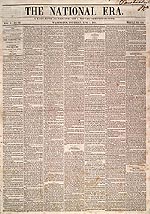
CLICK IMAGE TO ENLARGE
One could say that the strength of her analysis came out of her identification as a woman with the lowly and the oppressed and that the limits of her novel were a function of her class and race — except that the examples of "true womanhood" she modeled were themselves a function of class and race. Like many Yankee women with years of tradition behind them and confidence in their domestic "faculties," she displayed condescension toward both her black and her immigrant help. But it is impossible to read the works of Harriet Beecher Stowe without being impressed by the power of sympathy that pours out in all directions, a power that, as an artist, she needed to imagine in realistic detail the wide variety of social types who inhabit her fictions. In order to create Tom Loker and Simon Legree she had to feel what it was like to be them, to let them, as well as the horrors of slavery, enter into her consciousness. It takes a certain kind of temperament to do this, a temperament at once strong and optimistic (so as not to "sink" under the horror) and deeply sympathetic and almost medium-like. The visionary qualities of Stowe's fiction make it a ground of revolutionary potential, woven from common strands of daily life and fraught with all the contradictions of that life.
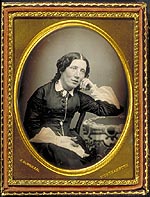
CLICK IMAGE TO ENLARGE